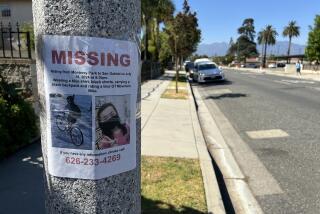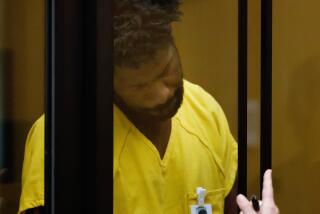An affair led to his conviction in a co-worker’s murder. Now, he is free and the victim’s husband has been arrested
- Share via
When authorities found the body of Terry Cheek on rocks near Corona Lake’s shoreline two decades ago, they also found a watch.
That timepiece, found next to the strangled body of the married mother of two, belonged to Horace Roberts, a co-worker with whom she was having a secret affair, Riverside County prosecutors insisted.
“What is more compelling than [Horace Roberts’] watch that’s found next to the murdered woman’s body? There’s nothing more compelling than that,” prosecutors told jurors at Roberts’ July 1999 trial.
After three trials, Roberts was convicted in Cheek’s murder — based mostly on the Lorus watch that was found next to her body. A type of watch Roberts acknowledged owning.
But DNA testing in March forced by the California Innocence Project revealed that DNA from Cheek’s fingernails did not belong to Roberts, but rather to someone related to her husband.
Two weeks ago, Roberts was secretly freed from prison after both the Riverside County district attorney and the California Innocence Project agreed that he was wrongly convicted and that two other men are responsible for Cheek’s death in April 1998.
The new suspects — Cheek’s husband, Googie Harris Sr., 62, and a nephew, Joaquin Leal III — were arrested Friday on suspicion of murder.
Riverside County Dist. Atty. Michael Hestrin announced the arrests Monday as well as the collaboration between the California Innocence Project that led prosecutors to dismiss Roberts’ conviction.
“What happened to Mr. Roberts is tragic,” Hestrin said. “We as prosecutors always strive to be vigilant and follow the truth. Once I learned of the new DNA findings, I immediately directed that all charges be dismissed. Mr. Roberts has my commitment that we will aggressively apply new technologies to past, present and future prosecutions. And I commit to him the resources of our Victim Services Division to help him in rebuilding his life.”
The District attorney Monday asked a judge to find Roberts factually innocent in Cheek’s murder, scrubbing his entire criminal history connected to the death from the records. Leal and Harris, he said, have been charged in Cheek’s killing and held in lieu of $1 million bail.
The day he was released, Roberts enjoyed a simple pleasure. “This is what I love ... this is what I missed more than anything — my freedom,” the 60-year-old said after sipping a bottle of Pepsi in the back of his lawyer’s car and getting a new set of clothes. He then flew to the East Coast, where relatives greeted him with hugs and tears.
Justin Brooks, the founder of the California Innocence Project, said that Cheek’s husband had “set up Roberts.” “It’s the oldest story there is in the murder business. Husband kills wife who is cheating on him. The twist, in this case, is that the husband set up the lover to go to prison for the rest of his life.”

Cheek vanished the night of April 13, 1998. She never arrived at her late-night shift at Quest Diagnostics, where she worked with Roberts. Four days later, her strangled body was found along the highway near the craggy shore of Corona Lake, halfway between Corona and Lake Elsinore. The last people to see her alive were said to be her two daughters and her husband.
Suspicion quickly turned to Roberts, who colleagues at the medical company suspected was having an affair with Cheek. Roberts lied to Riverside County sheriff’s deputies when questioned about the liaison.
Roberts, who also lied to his co-workers about the affair, did so out of shame and embarrassment, his lawyers said. But detectives hunting for a killer saw it as an effort to cover up his role in the brutal slaying.
During three trials, two of which ended in a hung jury, prosecutors would show jurors Roberts’ inconsistent statements, characterizing them as lies designed to cover up a murder. They pointed out the presence of his truck near the crime scene and a purse in his possession that one of Cheek’s daughters swore her mother had left with the night she disappeared.
But more than any other evidence, the watch found next to Cheek’s body would lead to Roberts’ conviction. He was sentenced to 15 years to life for second-degree murder.
From his prison cell, Roberts reached out to the California Innocence Project. Over the next decade, lawyers sought DNA testing from Cheek’s fingernail scrapings, the rope that was used to strangle her and the watch found near her body.
The organization’s legal team in 2013 filed a petition for a writ of habeas corpus on behalf of Roberts. Michael Semanchik, managing attorney for the California Innocence Project, said that watch had the DNA of Harris’ son on it and clearly was not Roberts’ watch.
Superior Court Judge David A. Gunn, however, denied the petition in 2014, finding Roberts did not “completely undermine the entire structure upon which the prosecution is based” and the evidence did not unerringly point to his innocence.
Gunn, nonetheless, did note that if he were to be using the lesser burden for “material false evidence,” he probably would have granted a new trial because the evidence “surely raises the specter of reasonable doubt.”
Gunn also green-lighted more DNA testing of evidence. In 2017, the crime scene evidence was sent to the California Department of Justice laboratory in Riverside, which did a more sophisticated DNA test than available in 1998. The DNA from Cheek’s left-hand fingernails matched to Leal in March and he and Harris became the focus of a new probe. Blood on Cheek’s pants appeared to be that of another unknown man.
Roberts’ lawyers say that Cheek often borrowed his truck for errands and that she or her killers drove it down the highway and parked it near the lake in 1998.
Two months after Cheek’s killing, Leal was charged with molesting a child under 14. He was convicted of oral copulation of an unconscious victim in August 1998. He served six months in jail and was required to register as a sex offender. His DNA became part of the state criminal database.
“No one had any idea who Leal was since his name did not appear in any of the case files,” said Semanchik, one of Roberts’ lawyers. But Leal’s victim in his sex crime case, according to Semanchik, was the child of a woman Harris had dated after Cheek’s death.
Twitter: @lacrimes
UPDATES:
5 p.m.: This article was updated with additional information about the case.
This article was originally published at 2:05 p.m.
More to Read
Sign up for Essential California
The most important California stories and recommendations in your inbox every morning.
You may occasionally receive promotional content from the Los Angeles Times.














